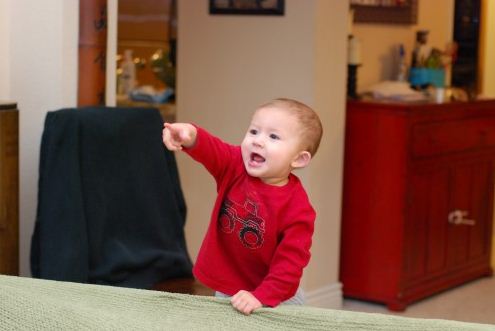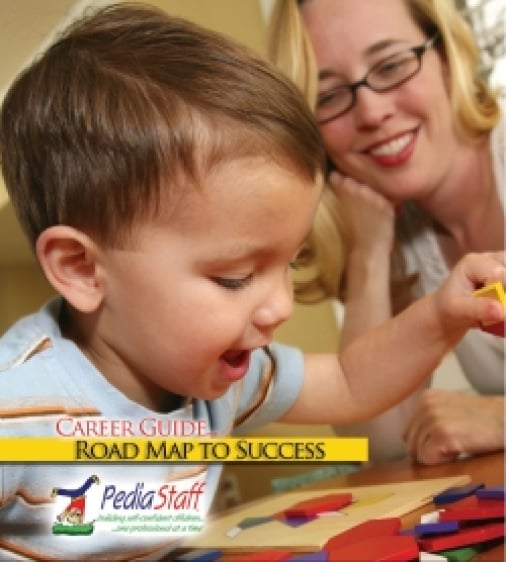SLP Corner: The Importance of Pointing
by Katie Yeh, M.S. CCC-SLP, Playing With Words 365
I feel like Everett, with the exception of walking, has hit every developmental milestone earlier than his older sister. He sat up, crawled and spoke his first word earlier than she did. Yeah yeah yeah, I know you aren’t supposed to compare your children but I’m sorry: I am human and I will compare them sometimes. Plus, as a speech pathologist AND mommy, I have always been fascinated with development in general, so I find it interesting how my two children have developed a little differently.
At a year old, it was like a switch was turned on and Ev started pointing and “talking” about EVERYTHING. This kid is obsessed at pointing at things and “discussing” them with us. You know, very intellectual conversation. For example-”babababaguhdadadadada” or “guhguhguhguhbababababamamamamama”.
Yes, he is a pointing and babbling machine these days. Which, is very different from his older sister at the same age. She never pointed this much!
When I am doing an assessment on a child, one of the questions I always ask is does the child point to objects of interest. I have had many a parents wonder why this is so important. As an SLP I have always known why it is so important, but now that I have children I know firsthand how important it is.
Let’s look at what happens when our infant or toddler points to something. Let’s see the various things that their pointing can make US do…
It makes us look at what they are pointing at.
When your toddler points at something, generally the first thing you do is look at what they are are pointing at. This pointing is your child initiating joint attention. That is, your child wants you to attend to the same item of interest as they are attending to. Joint attention is a very important communication and social skill.
“The frequency with which infants engage in joint attention is related to their language acquisition, even when variance associated with general cognition is controlled (e.g., Morales et al., 2000; Mundy et al., 2007). Joint attention is also associated with the depth of information processing in infants (Striano, Chen, Cleveland, & Bradshaw, 2006), as well as with individual differences in childhood measures of IQ, self-regulation, and social competence (Mundy et al., 2007).” (Mundy & Newell, 2007). Children who do not initiate joint attention can have great difficulty learning language, participating in symbolic play, understanding social cues, and learning by observing/watching others.
(Click HERE to read the whole article Attention, Joint Attention, and
Social Cognition by Peter Mundy and Lisa Newell that I quoted above.)
It makes us label what they are pointing at.
When your child points to something, one of the first things you may find your self doing is simply labeling the item of interest. For example, let’s say your son points to an airplane in the sky… you probably will say something like “Look! It’s an Airplane!” This is how your child will learn the names of many objects, by pointing at them and showing you.
It makes us describe what they are pointing at.
After you have labeled the airplane, you may find yourself describing it. You may find yourself saying something like “Yes, that’s an airplane. It is flying high in the sky. The pilot is flying the plane!” Now your child is learning more words like flying, high, sky, and pilot in addition to the label airplane. So far, your child has been exposed to five new words, simply by pointing out an object to you!
It makes us ask them questions about what they are pointing at.
In addition to labeling and describing, you may also find yourself asking your child questions about the object that you know they can’t actually answer yet. For example, you may say something like “Do you hear the sound the airplane is making? It’s going rrrrrrrrrrrr!” Or maybe when it starts to get farther away “Where is the airplane Johnny? Where did it go?” Asking your child these questions, even though they can’t answer them yet, is providing your child with a model for asking questions. Children learn from what they hear and see.
When should we expect a child to be pointing?
Like any developmental skill, there is a range of “typical”. When I was doing research for this post, there was a pretty large range for pointing: most sites said around 12 months with a range of 9-15 months, with one site even saying 18 months. However, it is important to note that this range includes all forms of gestures, and not just pointing. This includes gesturing towards items, clapping, waving, or using other gestural communication. A gesture is defined by the use of a bodily action (hands, face, head or other parts) that is used to convey some sort of message, either without speech or paired with speech. So if your child is 12 months and is not pointing but he is using other forms of gesturing to communicate, hold tight because it probably going to come soon! That said, if your child is not pointing to share with you items of interest by 15 months, I would consult your pediatrician just in case.
What can I do to help teach my infant/toddler to point?
- First of all, model, model model. I do wonder if many Ev is pointing so much because he has his older sister to model. Modeling pointing is very important.Walk around your home and point out and label objects. Do the same at the park, the grocery store, in the car.
- Play pointing games with your toddler. Point to your body parts and his body parts while labeling.
- Blow bubbles for your child, and practice popping them with your fingers…many children will naturally use their first finger to try to pop them. Model both pointing at the bubbles and popping them. Make sure you are using language the whole time.
- When your child does start to point, the best thing to do is get REALLY excited about whatever it is he is pointing to! Give lots of attention about the pointing, which will provide positive reinforcement resulting in more pointing.
- Some children with delays, like those with autism, may need more direct teaching on how to point, like hand-over-hand instruction with immediate reinforcement. This type of instruction needs to be tailored to the specific child by a professional (and then taught to the parents) such as a speech-language pathologist or a board certified behavior analyst.
Most children will start pointing to objects on their own. Modeling, and modeling often, is the best course of action in the beginning. If your child is not pointing by 15 months, or is not using any gestures by 12 months, you should bring it up with your pediatrician just to be safe.
Featured Guest Columnist / Website: Katie Yeah of Playing With Words 365
Katie is a speech-language pathologist, mother, and blogger. In addition to holding her state license and rehab credential, she also holds a certificate in Applied Behavior Analysis. She lives in California with her husband and two children E (3) and Ev (15 months). She blogs at Playing With Words 365, where she provides information for parents, educators, and other professionals on how to expand children’s speech and language skills through play, reading, music, crafts and other daily activities.
Please Support our Contributors and Visit Playing With Words 365.
dup
PediaStaff is Hiring!
All JobsPediaStaff hires pediatric and school-based professionals nationwide for contract assignments of 2 to 12 months. We also help clinics, hospitals, schools, and home health agencies to find and hire these professionals directly. We work with Speech-Language Pathologists, Occupational and Physical Therapists, School Psychologists, and others in pediatric therapy and education.

